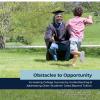Obstacles to Opportunity: Increasing College Success by Understanding & Addressing Older Students’ Costs Beyond Tuition


 Shared by Housing Is
on May 20, 2021
Shared by Housing Is
on May 20, 2021

 Shared by Housing Is
on Oct 6, 2020
Shared by Housing Is
on Oct 6, 2020